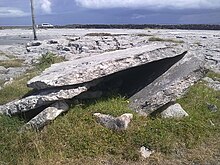Diarmuid and Gráinne
Diarmuid and Gráinne ( Irish Tóraíocht Dhiarmada Agus Ghráinne , in older spelling Tóraigheacht Dhiarmada Agus Ghráinne [ 'toːrijaxt' jiarmada 'Agus' ɤraːNʴe ] dt. "Running away from Diarmuid and Gráinne " Old Irish also Aithed Gráinne re Diarmait , "The abduction of Gráinne through Diarmait ”) is a story from the Finn cycle , the southern Irish saga about Fionn mac Cumhail (older spelling Finn mac Umaill).
Work history
The legend is recorded in the "Book of Leinster " ( Lebor Laignech ), one of the most extensive older manuscripts. This work was written in the sixties of the 12th century by the abbot of Terryglas ( County Tipperary ), Aed mac Crimthainn, the prímsenchaid ("main historian") of Leinster. The manuscript is, albeit incomplete, in the College library of Trinity of Dublin kept. It contains five legends from the Fenian cycle about Finn mac Umaill, including "Diarmuid and Grainne". Text allusions settle this legend in the 9th to 10th centuries, as it is assumed to be known in other old stories. The first complete record, however, is only from the 14th century.
This legend is one of the Celtic sources of Tristan and Isolde . The Irish sagas Scéla Cano meic Gartnáin (“The story of Cano, Gartnan's son”) and Longas mac nUislenn (“The exile of the sons of Uislius”), in which the fate of Naoise and Deirdre is described, deal with the same topic .
content
Finn is no longer the radiant youthful hero, the indomitable leader of the Fianna , but an old and jealous widower who is looking for a younger wife. His son Oisín suggests Gráinne, the daughter of the High King Cormac mac Airt , although Finn lives in disagreement with him. He therefore sends Oisín and his friend Diorraing to the court of Gráinne's father in Tara as courtiers . Cormac wants his daughter to decide for herself, but she believes that Oisín is coming to promote herself. Only when Finn arrives with his entourage when she says I do, she realizes her mistake at the banquet in the hall. That's why she walks around with a precious tankard and lets everyone drink from it. Diarmuid, who she likes best, afflicts her with the spirit of destruction if he does not abduct her that night. Diarmuid cannot escape this, because it outweighs his allegiance to Finn. His brothers decide to help him with this "matter of honor" and flee with him from Finn's anger.
They find their first refuge in Connacht , where Diarmuid declares himself to be the future husband of Gráinnes to Finn who has succeeded them. Since Finn threatens him with death and has surrounded his camp, he flees with a "dive" over the besiegers. A messenger from the Other World brings them to the seashore, where Diarmuid has to defend himself against three fighting dogs and a thousand warriors. They can rest for a while in the sacred mountain ash trees of the Túatha Dé Danann until they are found again. The god Oengus , his foster father, helps him to make peace with Finn, which Finn refuses to keep. He lures Diarmuid into a trap by letting him fight a boar that will die with him due to a geis . Diarmuid kills the boar with his spear, which tears his body open with his last strength. Despite all the pleas and threats of the Fianna warriors, Finn refuses the deadly wounded enemy the drink of water from his hand, which would heal him and Diarmuid dies. Oengus takes the dead into the síd of New Grange ; Gráinne distributes his weapons to her children so that one day they can avenge their father.
Fenier ballad
The Fenier ballads belong to the beginning of ballad poetry , a literary genre that appeared in Ireland in the 12th century. An example is the lullaby Gráinne sings for Diarmuid at the watch:
Codail beagán, beagán beag, óir ní heagail duit a bheag, ...
Sleep a little, just a little, for there is no danger in a little sleep,
young man whom I have given my love, Diarmaid, son of Ó Duibhne.
Sleep well here, noble Diarmaid Ó Duibhne;
I will watch over you, beautiful son of Ó Duibhne.
Traces of the legend
Some dolmens (barrows) in Ireland are still called Leaba Dhiarmuid agus Grainne or Leaba Dhiarmada 'is Gráinne ("Bed of Diarmuid and Gráinne") one of them is on the island of Inishmore ( Oghil Wedge tomb ). Either the mountain Ben Bulben ( County Sligo ) or the Tor Gulbin in Lochaber in the Scottish Highlands are named as the place of his death (this can be explained by confusing the names, since the Ben Bulben was also called Ben Gulben). Diarmuid and Gráinne are said to have lived in a cave on their escape, and a rock formation in the cave is known as Leaba Dhiarmada agus Gráinne ("The Bed of Diarmuid and Gráinne").
See also
literature
- Helmut Birkhan : Celts. Attempt at a complete representation of their culture. Publishing house of the Austrian Academy of Sciences, Vienna 1997, ISBN 3-7001-2609-3 .
- Helmut Birkhan: Post-ancient Celtic reception. Praesens Verlag, Vienna 2009, ISBN 978-3-7069-0541-1 .
- Myles Dillon, Nora Kershaw Chadwick : The Celts. From the prehistory to the Norman invasion . Kindler's cultural history, ISBN 3-89340-058-3 .
- Ingeborg Clarus : Celtic Myths. Man and his otherworld. Walter Verlag 1991, ppb edition Patmos Verlag, Düsseldorf, 2000, 2nd edition, ISBN 3-491-69109-5 .
Individual evidence
- ↑ Helmut Birkhan: Celts. Attempt at a complete representation of their culture. P. 469.
- ↑ a b Myles Dillon, Nora Kershaw Chadwick: The Celts. From the prehistory to the Norman invasion p. 447.
- ^ Ingeborg Clarus: Celtic myths. Man and his otherworld. P. 231 f.
- ↑ Helmut Birkhan: Celts. Attempt at a complete representation of their culture. P. 454, note 1.
- ↑ Helmut Birkhan: Nachantike Keltenrezeption. P. 175.
